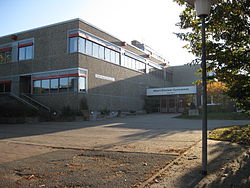Albert-Einstein-Gymnasium Hameln
| Albert Einstein High School | |
|---|---|

|
|
| type of school | high school |
| founding | 1972 |
| address |
Knabenburg 2 |
| place | 31785 Hameln |
| country | Lower Saxony |
| Country | Germany |
| Coordinates | 52 ° 7 '1 " N , 9 ° 22' 10" E |
| carrier | City of Hameln |
| student | 691 (2019/20) |
| management | Sönke Koß |
| Website | www.aeghm.de |
The Albert-Einstein-Gymnasium is a high school founded in Hameln in 1972 . It is an open all-day high school as well as a European and CertiLingua school. It is currently attended by 844 students.
prehistory
Hameln traditionally had two grammar schools, which were run in three classes. These were the grammar school for boys ( Schiller grammar school ), which has an ancient language and a mathematical and scientific branch, and the modern language grammar school for girls (the Viktoria Luise school ). Access was limited by an entrance exam or trial lesson. In 1965, the frequency of classes in grades 5–10 was reduced from 40 to 35, the trial lessons were dropped - and there were no rooms or teachers. It was not until 1972 that a new grammar school was set up in Hameln by the Albert Einstein grammar school.
history
On September 5, 1972 began on III. Gymnasium, as the Albert Einstein Gymnasium was called in the first years of its existence, teaching for the first 161 students. The inauguration and the move into the building did not take place until mid-September 1972. At first there were only 5 classes of the 5th year and the staff consisted of only eight teachers. In 1973 there was a further expansion in three stages. The new years 5, 7 and 11 came at the same time and the grammar school consisted of 16 classes with a total of 499 students. Among them were 64 pupils from the Viktoria-Luise-Schule and 58 pupils from the Schiller-Gymnasium.
The III. High school as a prototype of a coeducational high school was founded as a modern language and mathematical-scientific high school for boys and girls. In addition, a math and science class was set up as an advanced trainer for secondary school graduates. By 1977 the number of students rose to 1,272. The student library was also created as a reference and lending library. It comprised 2,000 volumes in 1975 and 2,600 in 1976. In 1975 the school received a language teaching system.
With the introduction of the reformed upper level in 1975, lessons in grade 11 were partially and in grades 12 and 13 completely in individually selectable courses instead of in the traditional class group. In addition, a diverse range of working groups was set up, such as theater, literature, photography, the history of Hameln, choir, orchestra and folk music, some of which achieved regional fame. Mention should be made here of the “folk group”, the theater group, the rock music group, the student exchange programs with England, USA, France, Israel and Hungary, the Provence trips and the ski courses in South Tyrol. The school magazine Aragorn, which has been published since 1978, was created in this context.
In 1978 the school became a training school when the Hameln study seminar was founded. Trainee lawyers have been trained here since then . At the same time, the discussion about naming the III. High school, which after six years of existence still had a working title. After lengthy discussions at school and in politics in Hamelin, the Hamelin city council decided with a narrow majority in favor of the name Albert-Einstein-Gymnasium and not the name Carl-Zuckmayer-Gymnasium favored by the CDU. The renaming of the III. Gymnasium took place on the 100th birthday of Albert Einstein on March 14, 1979.
The exchange programs were expanded to include contacts to Israel and a second English school in Alton. Connections to the Albert-Einstein-Gymnasium in Böblingen were established.
The school offer was expanded in 1993 with bilingual teaching . In 1995 the school applied to participate in the nationwide pilot project "Self-Effective School". From autumn of the same year, the school took part as a pilot school in Lower Saxony in this three-year project of the federal state commission for educational planning and research funding, whereby the team model was carried out as part of this project.
The structural completion of the school is causing unsolved problems to the present, because many of the initially planned rooms, especially an auditorium, were not built. The architects' right to have a say also made subsequent renovations more difficult. In 1984 there was a minor renovation of the interior. In 1996/1997 the area between the southern front and the Sertürner Realschule was rebuilt. Since autumn 2009 the school has also had a canteen due to the renovation and expansion of the cafeteria, which is now regarded as a prerequisite for all-day classes due to the now possible supply of warm lunches.
principal
- 1972 to 1984: Friedrich Flügge
- 1984 to 2000: Bernhard Arend-Schneider
- 2000 to 2017: Wolfgang Weber
- 2017 to 2019: Christian Martin Schmidt
- 2019 to 2020: Acting director Bettina Schröder-Brautlecht
- 2020 until now: Sönke Koss
Personalities
Teacher
- Bernhard Gelderblom (* 1943), historian and author
- Lutz Führer (* 1945), mathematician
student
- Jens Rosteck (* 1962), writer and musicologist
- Susan Stahnke (* 1967), actress and television presenter
- Mathias Mertens (* 1971), author, media scientist and air guitar player
Web links
Individual evidence
- ↑ City of Hameln - Urban Development Department: Statistical Data 2019. (PDF) Retrieved on February 8, 2020 .